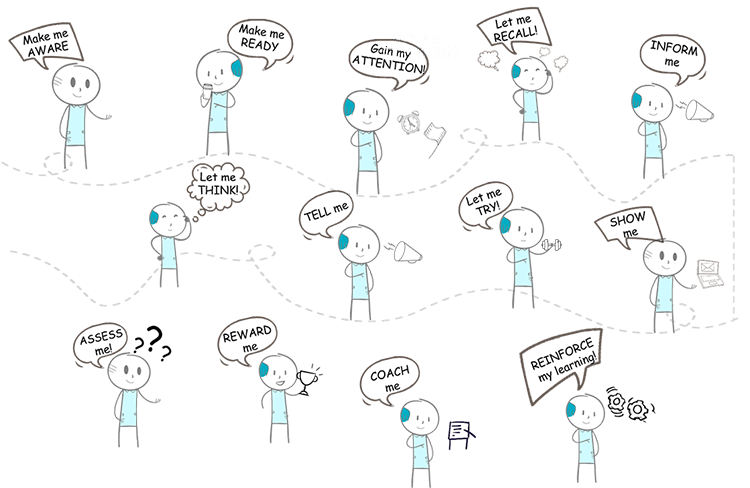Blended Learning For The Hybrid Workforce
As per the recent 2022 Gartner Organization and Work Design Survey, hybrid and remote employees are 40% more likely to experience high levels of work friction. [1] The burnout that follows is inevitable. Managing hybrid workforces is a challenge not many organizations are up for. Too many processes need change. A large part of digitalization is required, and so is seamless availability. If not addressed in a time-bound manner, these challenges hinder growth when it comes to implementing Learning and Development initiatives for a hybrid workforce. With hybrid workforces being implemented across the globe, how are training managers coming up with effective training programs?
Let us see the significance of blended learning in a hybrid workforce. But before that, it is important to understand what blended learning is!
Blended Learning In A Nutshell
Blended learning, in a nutshell, is a customized approach for learning delivery where different modes of learning are fused together to create one blended solution.
For example, one can complement a virtual instructor-led eLearning session by supporting videos, interactive polls, infographics, hands-on training, online quizzes, one-on-one breakouts, and so on. The idea is to leverage the best of all available training modes and design a solution that meets learning, training, and business objectives. Since it is a combination approach, the key takeaways are the benefits across the learning mediums.
Blended learning offers far-reaching benefits for corporate training. Watch the video to know more about the benefits of how different blended learning formats can facilitate specific training types.
Significance Of Blended Learning
Now that we have a clear understanding of what blended learning is, let us explore and understand the significance of it.
-
Seamless Transition
Initially, many organizations were forced to move to hybrid learning models due to the disruption caused by the pandemic. But not anymore. Now, organizations are voluntarily moving, as the transition from classroom training mode to a blended learning model is seamless. The shift is welcomed by learners alike, especially when the workforce is geographically dispersed and working remotely.
-
Facilitate Learning
The "24/7 anytime, anywhere access" promotes self-paced learning. To add to that, the modules are designed to work on multiple platforms across devices. So, be it a mobile phone, tablet, or desktop, learners can switch and choose their preferred learning platform. Moving from online modes to offline modes is easy as well. Learners can learn at their own pace, device, and convenience. Additionally, blended learning accommodates various learning styles, thus encouraging learning amongst the participants.
-
Builds Learning Culture
Learners can nurture a collaborative learning environment by using interactivities such as discussion groups, forums, and social channels. The positive and productive learning experience helps to foster a continuous learning culture. The organization-wide learning culture strengthens learning journeys and helps to keep learners engaged. Moreover, a learning culture establishes a path for career growth and draws higher interest in employees to upskill, thereby improving employee retention.
-
Scalable Solution
The modes of the solution can be altered, adjusted, and updated quickly, making the solution scalable to meet multiple learning objectives and training needs. For instance, compared to legacy training solutions, blended learning is a way more cost-effective solution, experts believe. Any classroom course can be converted into digital assets. This helps organizations directly by reducing development time and costs associated with training materials, investing their L&D budgets smartly, and exploring innovative learning technologies. Cost savings can be realized on travel, accommodation, learning assets, and more.
Formats Of Blended Learning
The true beauty of a blended learning solution is the correct mix of training methods and formats. What are the different options that can be utilized in a corporate training scenario?

Commlab India
Self-paced learning – Video-based training sessions and microlearning assets can be implemented for this type of learning. The courses can either be standalone or a curriculum based on the requirement.
Just-in-time training – Mobile learning, microlearning assets, simulations, job aids, and digital inventories are some key elements that can be used for this type of learning.
Social learning – Online team meetings, discussion forums, message boards, town hall meetings, and channels that facilitate learners to engage, communicate, and share learning can be availed under this type of learning.
Performance support – Mobile applications, interactive job aids, scenario-based trainings, and how-to guides are some options that can be incorporated to provide the required support.
Blended Learning: Hybrid Workforce, Hybrid Learning
"The only thing worse than training your employees and having them leave is not training them and having them stay." — Henry Ford, Founder, Ford Motor Company
In a recent Gartner research, L&D leaders vouched for an effective hybrid learning environment for fairness, relevance, and enhanced productivity. [2] A good combination of thoughtfully designed learning resources enables learners to get the most out of their training, which drives learning effectiveness and improves training outcomes.
A hybrid workforce needs a hybrid learning solution. Leveraging a blended learning approach enables training managers to build an effective learning program and promote a continuous learning culture. Blended learning is not just a trend, it is here to stay.
Get started on your blended learning initiative today!
References:
[1] The key to retaining hybrid workers? Address work friction
[2] Leadership Vision for 2023: L&D Leaders








